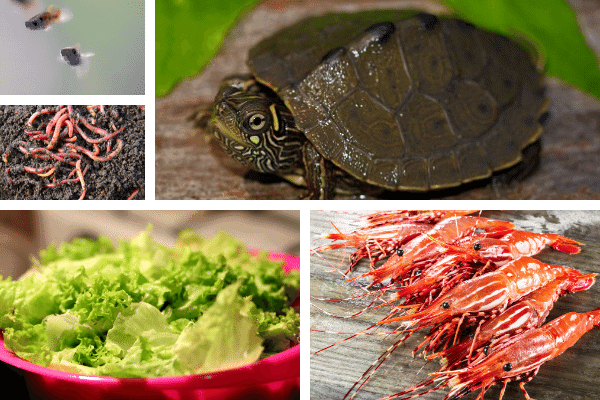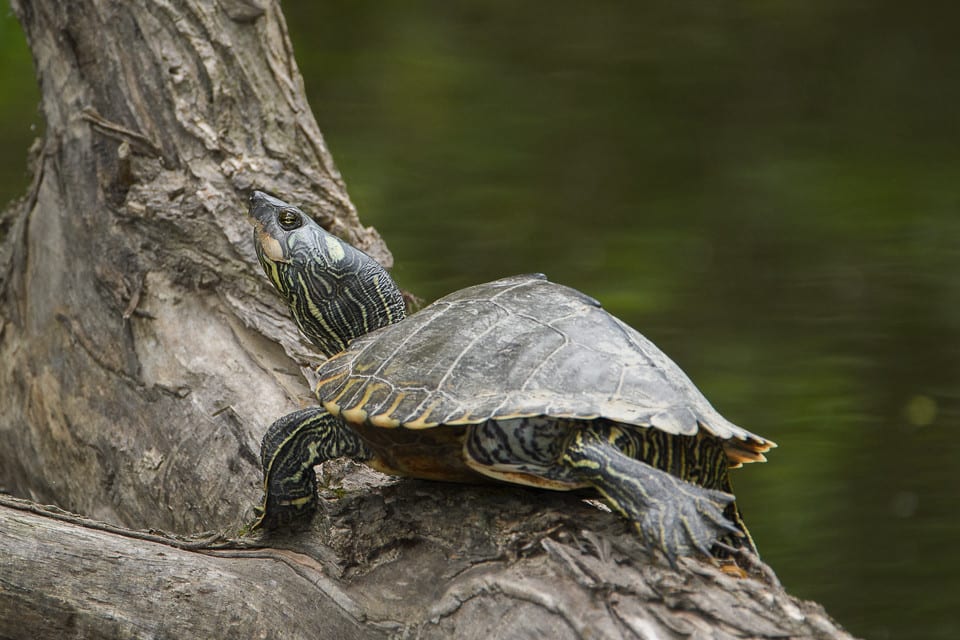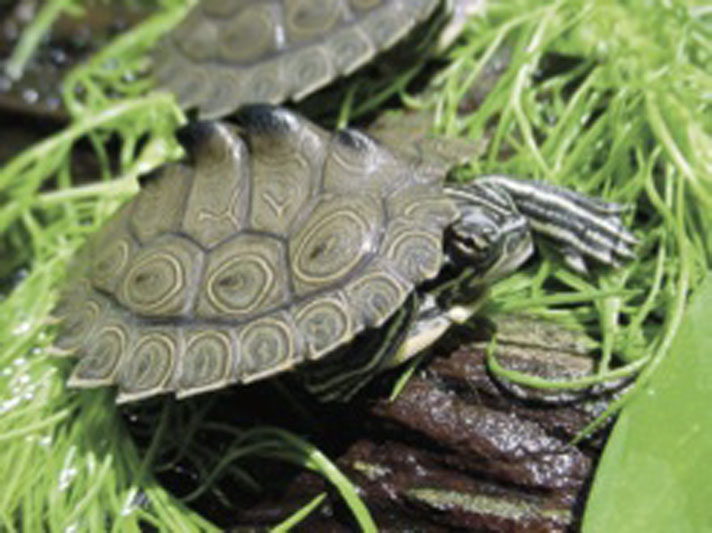Map Turtle Care .Map turtles are one of the most popular turtle species kept as pets. They’re relatively easy to care for and make great additions to any reptile collection. In this care guide, we’ll go over everything you need to know about map turtle care.
From housing to diet, we’ll cover it all!
Map turtles are a type of semi-aquatic turtle that is native to North America. They get their name from the map-like patterns on their shells. Map turtles can grow to be quite large, with some species reaching up to 18 inches in length.
If you’re thinking about getting a map turtle as a pet, there are a few things you need to know about their care. First, map turtles need access to both land and water in their enclosure. They should have a basking area where they can dry off and warm up, as well as a large water area for swimming and soaking.
Map turtles are also known for being very active, so you’ll need to provide them with plenty of space to explore. A good rule of thumb is to have at least 10 gallons of space for every inch of your turtle’s shell length. So, if you have a 4-inch turtle, they should have at least 40 gallons of space available to them.
Another important thing to keep in mind is that map turtles are escape artists! Their enclosures will need to be secure, with no gaps or openings that your turtle could squeeze through. It’s also important to make sure that any tanks or ponds you have set up are deep enough that your turtle can’t just climb out – they should be at least twice as deep as your turtle is long.
Providing your map turtle with the proper care will help them stay healthy and happy for many years to come!
What Do Common Map Turtles Eat
If you’ve ever wondered what common map turtles eat, wonder no more! These freshwater turtles are opportunistic feeders, which means they’ll eat just about anything they can get their hands on. This includes insects, small fish, crustaceans, and even aquatic plants.
Basically, if it’s small enough to fit in their mouth and they can catch it – they’ll eat it!
As far as captive common map turtles go, their diet should be varied in order to provide them with all the nutrients they need to stay healthy. A good diet for a captive common map turtle includes: commercial turtle food pellets or sticks, live or frozen/thawed insects (such as crickets or mealworms), live or frozen/thawed fish (such as minnows or goldfish), and fresh vegetables (such as dark leafy greens).
It’s important to offer a variety of food items so that your turtle gets all the nutrients he needs.
A word of caution: Common map turtles are known to be aggressive feeders, so make sure any tank mates are well fed before adding them to the enclosure. Otherwise you may find yourself with one very hungry turtle on your hands!

How Do Common Map Turtles Protect Themselves
Map turtles are a type of turtle that is found in North America. They get their name from the maps that are found on their shells. These turtles are usually between 4 and 10 inches long.
They can live to be over 20 years old.
Map turtles are semi-aquatic and can be found in rivers, streams, lakes, and ponds. They are good swimmers and can even climb trees!
These turtles spend most of their time in the water but will bask on logs or rocks when the weather is warm. Map turtles hibernate during the winter months at the bottom of rivers or lakes.
Map turtles have a few predators including raccoons, opossums, skunks, mink, otters, weasels, herons, egrets, crows, and gulls.
To protect themselves from these predators they will hide under logs or rocks in the water or on land. If a predator does manage to catch them they will often times drop off their shell which confuses the predator and gives the turtle time to escape!
Common Map Turtle Weaknesses
The Common Map Turtle is a species of turtle that is native to North America. These turtles are known for their unique shell patterns, which can vary significantly from individual to individual. Common Map Turtles typically grow to be between 4 and 10 inches in length, with females being larger than males on average.
Despite their name, Common Map Turtles are not especially common in the wild and their populations are believed to be in decline. This decline is likely due to a number of factors, including habitat loss and degradation, pollution, and predation by invasive species. Common Map Turtles are also popular pets, which may contribute to their decline in the wild as turtles that are captured for the pet trade are often removed from breeding populations.
Common Map Turtles have a number of weaknesses that make them vulnerable to these threats. First, they have a very slow growth rate, meaning that it takes them many years to reach maturity and begin reproducing. Second, they have low hatching success rates; even under ideal conditions, only a small percentage of eggs laid by Common Map Turtles will hatch and survive into adulthood.
Third, adult turtles have few natural predators but juvenile turtles face high mortality rates from predators such as fish, snakes, and birds. Finally, like all turtles, Common Map Turtles can live for many years but they have relatively short life spans when compared to other vertebrate animals; this means that any declines in population size will take many years to recover from.
Map Turtle Habitat
Map turtles are a type of freshwater turtle that is commonly found in North America. There are 11 different species of map turtles, and they can be found in a variety of habitats including rivers, streams, lakes, and ponds. Map turtles get their name from the patterns on their shells, which resemble the contours of a map.
Most map turtles spend the majority of their time in the water, only coming ashore to bask in the sun or lay eggs. Map turtles are omnivorous and will eat a variety of foods including insects, fish, crustaceans, and aquatic plants. Some species of map turtle are known to be quite aggressive towards other turtles and animals, while others are more docile.
Map turtles typically have a lifespan of 20-30 years in captivity, though wild populations may not live as long due to predation and other factors. If you’re interested in keeping a map turtle as a pet then it’s important to research the care requirements for your particular species as they can vary significantly.
What Do Baby Map Turtles Eat
When it comes to the diet of a baby map turtle, there are a few things that you need to take into account. The first is that these turtles are omnivores, which means that they will eat both plants and animals. The second is that their diet will change as they grow older.
And lastly, what you feed your turtle will also play a role in its health and growth.
As babies, map turtles will mostly eat insects and other small invertebrates. This is because their mouths are not big enough to eat anything else.
They will also consume some plant matter, but this should only make up a small part of their diet. As they get older, they will start to eat larger prey items such as fish, frogs, and crayfish. And eventually, they will be able to eat just about anything that fits into their mouth!
It is important to offer your baby turtle a variety of foods so that it can get all the nutrients it needs for proper growth and development. A good mix of animal and plant matter should do the trick. You can either buy commercial turtle food or create your own diets using fresh ingredients.
Just make sure that whatever you feed them is properly chopped up or grated so that they can easily consume it.

Credit: reptilescove.com
How Do You Take Care of a Map Turtle?
Assuming you would like tips on caring for a map turtle as a pet: When it comes to taking care of a map turtle there are a few key things you will need to provide. First, they need an aquarium that is at least 40 gallons and has a basking spot where the water temperature is around 80 degrees Fahrenheit.
The basking spot can be provided by either using a special bulb or basking platform that can be bought at your local pet store. In addition to the basking spot, you will also need to have a filtration system and UVB light in order to maintain clean water and help your turtle stay healthy. Map turtles are semi-aquatic so they spend time both in the water and on land.
Because of this, you will need to provide them with both hiding spots and plants that they can climb on. Hiding spots can be something as simple as upturned rocks or logs while plants can be live or artificial. It is important to have both since turtles like to feel safe and secure when they are out of the water.
As far as diet goes, map turtles are omnivores so they will eat both meat and vegetables. You can buy special turtle food pellets that have all the nutrients they need or you can feed them live food such as crickets, worms, or small fish. If you choose to feed them vegetables, some good options include kale, spinach, carrots, and zucchini.
It is important not to overfeed your turtle since this can lead to health problems down the road such as obesity. A general rule of thumb is to feed them enough so that their stomach appears slightly rounded after eating but not bloated. By following these simple tips, you can successfully take care of your map turtle!
Are Map Turtles Easy to Take Care Of?
Assuming you would like a blog post discussing the care of map turtles:
“Are map turtles easy to take care of?”
Map turtles are relatively easy to take care of compared to other turtle species.
They are semi-aquatic, so they require both land and water areas in their enclosure. Map turtles also need access to basking spots, where they can dry off and warm up. In terms of diet, map turtles are omnivores and enjoy a variety of foods, including pellets, insects, vegetables, and fruits.
Generally speaking, map turtles are hardy creatures that don’t require a lot of special care. However, there are a few things to keep in mind when caring for these turtles. First, map turtles can be aggressive towards each other, so it’s important to provide enough space for them to spread out.
Second, females tend to be larger than males, so it’s important to have an enclosure that can accommodate this size difference. Finally, because they’re semi-aquatic creatures, their enclosures need to be cleaned regularly (at least once a week) to prevent the build-up of harmful bacteria.
Overall,map turtles make great pets for beginner turtle enthusiasts!
How Do You Care for a Barbour Map Turtle?
If you’re thinking about adding a Barbour’s map turtle to your family, there are a few things you need to know about their care. These turtles are semi-aquatic, so they need both land and water in their enclosure. They also need access to a basking spot where they can warm up.
In the wild, Barbour’s map turtles spend most of their time in slow-moving rivers and streams with plenty of places to basking and hide.
When it comes to housing your turtle, a 40-gallon aquarium is suitable for one adult. If you plan on keeping more than one turtle, you’ll need a larger enclosure.
It’s also important to create different levels in the tank using rocks or logs so your turtle can climb out of the water when it wants to bask. Be sure to include plenty of hiding spots too.
Barbour’s map turtles are omnivorous, so their diet should consist of both plants and animals.
Commercial turtle pellets make a good base diet, but supplement this with fresh vegetables like kale and collard greens as well as live foods like crickets and worms. Feeding your turtle twice a day should be sufficient.
In addition to regular feeding, you’ll also need to provide your turtle with regular access to clean water for swimming and bathing.
Be sure to do weekly water changes and clean the tank regularly too.
Can You Keep a Map Turtle As a Pet?
Yes, map turtles can make great pets! They are relatively easy to care for and can live for many years with proper care. Map turtles are native to North America and can be found in a variety of habitats from rivers and streams to swamps and marshes.
Map turtles are semi-aquatic, meaning they need both land and water to thrive. In captivity, a map turtle enclosure should therefore include both a dry area where the turtle can bask in the sun as well as a large water area for swimming and diving. Map turtles are strong swimmers and will often spend hours underwater so it is important to provide them with a tank that is large enough for them to move around freely.
Map turtles are omnivorous, meaning they will eat both plants and animals. In captivity, their diet should consist of commercially prepared turtle food supplemented with live insects or worms. It is also important to offer your map turtle plenty of fresh leafy greens on a daily basis.
If you’re thinking about keeping a map turtle as a pet, be sure to do your research first. Make sure you have the time and resources necessary to provide your new pet with everything it needs to thrive!
SUPER SIMPLE Turtle Farm for Minecraft (Turtle Scute / Turtle Eggs)
Conclusion
If you’re looking for a pet turtle that’s both beautiful and unique, a map turtle may be the perfect choice! These turtles get their name from the intricate patterns on their shells, which resemble the lines of a map. Map turtles are native to North America and can be found in a variety of habitats, from rivers and streams to swamps and marshes.
Map turtles make great pets, but they do require some special care. For example, because they’re semi-aquatic turtles, they need both a water area to swim in and a land area to bask on. They also need plenty of hiding places so they feel safe and secure.
If you provide your map turtle with proper care, he or she can live for 20 years or more!





Leave a Reply